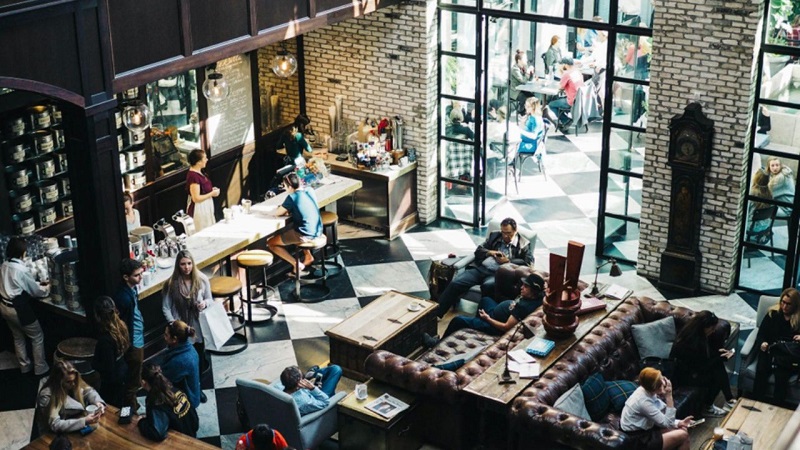- First impressions matter: thoughtful design can subconsciously shape how guests feel and behave in your space.
- Collaborating with experienced, locally aware professionals ensures fitouts are both beautiful and functional.
- Successful venues design with both the customer experience and staff workflow in mind to maximize efficiency and satisfaction.
- Tracking fitout success through customer behavior, social engagement, and operational improvements reveals its true ROI.
You know that feeling you get when you walk into a venue and everything just works? The lighting feels right, the layout flows effortlessly, and somehow the place already feels familiar. That’s not an accident—it’s the result of a carefully crafted fitout.
In the hospitality world, great food and service are essential, but they’re not the whole story. Design plays a massive, often underestimated role in the customer experience. Whether it’s a cozy wine bar tucked into a city laneway or a sprawling beachside café, the right fitout doesn’t just make a place look good—it makes it feel right.
So what is it that successful venues know about fitouts that others don’t? In this blog, we’re diving into the details. We’ll explore the psychological impact of first impressions, the value of expert help, and the secrets behind layouts that make both guests and staff feel at ease. If you’re planning a venue or rethinking an existing one, you’re going to want to read this all the way through.
The Hidden Psychology of First Impressions
When someone walks into your venue, they’re forming opinions before you even say hello. It happens fast—within seconds. The lighting, the colors, the flow of the space—all of it starts sending signals. Are they comfortable? Is this space meant for them? Do they want to stay?
Successful venues understand that a fitout isn’t just about decor—it’s about guiding emotions. Warm tones and soft lighting can make a room feel intimate and inviting. Open layouts give the sense of freedom and space. Even something as simple as how a guest moves from the entrance to the ordering counter can influence whether they’ll come back.
Take, for example, a café in Melbourne that repositioned its entrance and adjusted its seating arrangement. What changed? Customers started staying longer. Dwell time went up, and so did the average spend. The layout had been subtly steering them to the counter and out the door too quickly. Once that was fixed, the entire vibe of the place shifted.
Designing with psychology in mind isn’t manipulation—it’s consideration. It’s making people feel good without them even knowing why.
The Role of Experienced Partners in Successful Fitouts
You might have a clear vision for your venue. Maybe you’ve sketched it out, saved a dozen Pinterest boards, and walked through countless competitor spaces. But when it comes time to bring that vision to life, it’s the people you partner with who make all the difference.
Fitouts are more than just design—they’re compliance, logistics, functionality, and style all rolled into one project. That’s why successful venues almost always bring in professionals who get the hospitality landscape, not just general contractors. Experience in this space matters. A designer might know how to make a space look stunning, but a specialist knows how to make it work on a busy Saturday night.
That’s where local insight becomes a game-changer. Venues across the country are seeing the value of working with hospitality shopfitters in Australia. Why? Because these pros understand regional trends, building codes, customer expectations, and operational needs that vary from one state to the next. They’re not just building a pretty room—they’re crafting an experience tailored to your clientele and your location.
One Sydney bar owner credited their fitout success to the shopfitter’s input on acoustic treatments—something they hadn’t even considered. The result? A space that buzzed with energy without becoming deafening, keeping customers comfortable and conversation flowing.
Partnering with the right team means fewer surprises, smarter solutions, and a smoother journey from concept to opening night.
Function Meets Flair – Designing for Both Staff and Customers
A great fitout doesn’t just turn heads—it turns tables faster, too. The most successful venues strike a smart balance between looking amazing and working effortlessly behind the scenes. It’s easy to get caught up in choosing the right pendant lights or tiles, but if your staff is zigzagging through a poorly planned layout, that style quickly becomes a liability.
Think about your venue as a living, breathing system. There’s the front-of-house world where customers eat, drink, and relax—and then there’s the behind-the-scenes hustle that makes it all happen. When both of those worlds are designed in harmony, magic happens.
Start with the flow. Can staff move from the kitchen to the floor without bottlenecks? Is the bar laid out so bartenders can make drinks efficiently during a rush? Are service stations accessible yet unobtrusive? These are the details that separate the good from the great.
Now flip it around. What’s the experience like for your guests? Can they find the entrance easily? Is the ordering process intuitive? Do they feel comfortable lingering? Fitouts should anticipate your customers’ needs before they even think about them.
One Adelaide café nailed this by lowering a section of their counter specifically for accessibility. It wasn’t flashy, but it made all the difference for a segment of their clientele. When you take care of the details, people notice—even if they don’t say it out loud.
Form and function shouldn’t compete; they should collaborate. When they do, your venue becomes more than just a place to eat or drink. It becomes a place people love to be.
Evolving with the Trends Without Losing Identity
Design trends in hospitality change fast. One year it’s all about industrial minimalism, and the next, terrazzo and velvet are taking over Instagram feeds. But if there’s one thing successful venues have figured out, it’s how to evolve with style without losing who they are.
Customers crave spaces that feel current, but not at the expense of comfort or consistency. Your regulars come back because something about your venue feels familiar—they like the mood, the message, the vibe. So when you update your fitout, the challenge is keeping that identity intact while still offering something fresh.
That doesn’t mean you need to rip everything out and start over. Often, it’s the subtle updates that make the biggest impact. Changing out the lighting, refreshing the seating, or even just updating color schemes can give your space new energy without losing your soul.
Take a Brisbane cocktail bar that recently upgraded its furniture and added ambient lighting layers. The layout stayed the same, but the atmosphere was completely transformed. It went from trendy to timeless—and bookings jumped because the space felt elevated without being unrecognizable.
Materials matter too. Eco-conscious choices, sound-absorbing surfaces, and tactile finishes aren’t just trendy—they’re practical. They show your customers that you’re thoughtful about the environment and their comfort. And as expectations shift, keeping up with these kinds of details helps you stay relevant.
The best fitouts are like good storytelling. They evolve, they build, and they keep the audience coming back for more.
Measuring the Return on Design Investment
Let’s be real—fitouts aren’t cheap. But the venues that invest wisely don’t see it as a cost; they see it as strategy. The right fitout can improve operations, boost customer satisfaction, and most importantly, increase revenue. The key is knowing what to track.
Start with customer behavior. Are people staying longer? Are they posting photos on social media? Are they coming back more often? These subtle shifts can be early indicators that your space is connecting. If you’ve updated your design and suddenly your place is popping up on more Instagram feeds, that’s not a coincidence—it’s ROI in real-time.
Next, look at the numbers. Venues that refresh their interiors often see lifts in average transaction value. Maybe it’s because the layout encourages more add-on sales, or the new lighting highlights high-margin items. Whatever the reason, it’s measurable, and that’s powerful.
Also consider operational wins. Has the new kitchen setup sped up order times? Are staff happier and more efficient? A design that saves even a few seconds per order can stack up quickly in a busy service. That means better flow, less stress, and more capacity to serve.
The most successful venues don’t just design for looks—they design for growth. And they keep refining over time, using feedback and performance data to fine-tune their space. Because in hospitality, standing still is falling behind.
Conclusion
A fitout isn’t just about appearances—it’s a reflection of how your venue functions, how your team moves, and how your customers feel. The most successful hospitality spaces understand that design is more than décor. It’s strategy, psychology, and storytelling rolled into one.
By crafting spaces that balance beauty with practicality, evolving with trends while staying true to their core, and measuring the true impact of their investment, these venues set themselves apart. They don’t just open doors—they open experiences people remember.
And that’s the secret. It’s not just what’s on the plate or in the glass—it’s what’s all around it that brings people back.










Leave a Reply